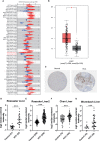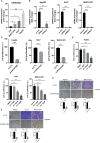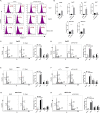Identification of PAFAH1B3 as Candidate Prognosis Marker and Potential Therapeutic Target for Hepatocellular Carcinoma
- PMID: 34490100
- PMCID: PMC8418329
- DOI: 10.3389/fonc.2021.700700
Identification of PAFAH1B3 as Candidate Prognosis Marker and Potential Therapeutic Target for Hepatocellular Carcinoma
Abstract
Background: Hepatocellular carcinoma (HCC) is the fourth leading cause of cancer-related deaths worldwide. PAFAH1B3 plays an important role on occurrence and development in a variety tumor. However, the function of PAFAH1B3 in HCC remains unclear.
Methods: The TIMER, ONCOMINE, Human Protein Atlas (HPA), GEPIA, The Cancer Genome Atlas (TCGA), HCCDB, UALCAN and LinkedOmics database were used to analyze the prognostic value, co-expression genes and regulator networks of PAFAH1B3 in HCC. siRNA transfections and inhibitor of PAFAH1B3 P11 were used to verify the anti-tumor effect on HCC cell lines. Gene expression was detected by qRT-PCR. The functions of PAFAH1B3 downregulation in HCC cell lines were investigated using cell cycle analysis, apoptosis detection, CCK8 assay and transwell assay. Western blot was used to evaluate the role of PAFAH1B3 on metabolic pathways in HCC cells.
Results: Based on the data from databases, the expression of PAFAH1B3 was remarkably increased in HCC patients. High expression of PAFAH1B3 was associated with poorer overall survival (OS) and disease-free survival (DFS). And PAFAH1B3 was notably linked to age, sex, grade, stage, race, and TP53 mutational status. Then, the functional network analysis showed PAFAH1B3 may be involved in HCC through cell cycle, cell metabolism, spliceosome, and RNA transport. Furthermore, the mRNA expression of PAFAH1B3 was also increased in HCC cell lines. Flow cytometry analysis showed that PAFAH1B3 manipulated apoptosis and cell cycle regulation. CCK8 assay showed that PAFAH1B3 silencing or pharmacologic inhibitor of PAFAH1B3 inhibited the proliferation of HepG2, Huh7 and MHCC-97H cells. Transwell assay results showed that PAFAH1B3 silencing also significantly impaired the invasion and migratory ability of HCC cells. In addition, PAFAH1B3 silencing significantly downregulated the expression of glycolysis and lipid synthesis signaling pathways.
Conclusion: Our findings suggested that PAFAH1B3 plays a critical role in progression of HCC. PAFAH1B3 as a prognosis marker and potential target for HCC has prospective clinical significance.
Keywords: PAFAH1B3; biomarker; cancer databases; hepatocellular carcinoma; prognosis.
Copyright © 2021 Xu, Lu, Liu, Chen, Huang, Huang, Liu, Zhu and Zhang.
Conflict of interest statement
The authors declare that the research was conducted in the absence of any commercial or financial relationships that could be construed as a potential conflict of interest.
Figures






Similar articles
-
CPNE1 is a potential prognostic biomarker, associated with immune infiltrates and promotes progression of hepatocellular carcinoma.Cancer Cell Int. 2022 Feb 9;22(1):67. doi: 10.1186/s12935-022-02485-2. Cancer Cell Int. 2022. PMID: 35139863 Free PMC article.
-
Centromere protein N may be a novel malignant prognostic biomarker for hepatocellular carcinoma.PeerJ. 2021 May 3;9:e11342. doi: 10.7717/peerj.11342. eCollection 2021. PeerJ. 2021. PMID: 33987018 Free PMC article.
-
Long non-coding RNA LINC01503 promotes the progression of hepatocellular carcinoma via activating MAPK/ERK pathway.Int J Med Sci. 2020 May 18;17(9):1224-1234. doi: 10.7150/ijms.45256. eCollection 2020. Int J Med Sci. 2020. PMID: 32547318 Free PMC article.
-
Overexpression of TCERG1 as a prognostic marker in hepatocellular carcinoma: A TCGA data-based analysis.Front Genet. 2022 Oct 10;13:959832. doi: 10.3389/fgene.2022.959832. eCollection 2022. Front Genet. 2022. PMID: 36299588 Free PMC article.
-
The Prognostic and Therapeutic Roles of ARL-6 Gene in Hepatocellular Carcinoma.Int J Med Sci. 2024 Jan 1;21(2):207-218. doi: 10.7150/ijms.88039. eCollection 2024. Int J Med Sci. 2024. PMID: 38169538 Free PMC article.
Cited by
-
Proteomics of adjacent-to-tumor samples uncovers clinically relevant biological events in hepatocellular carcinoma.Natl Sci Rev. 2023 Jun 2;10(8):nwad167. doi: 10.1093/nsr/nwad167. eCollection 2023 Aug. Natl Sci Rev. 2023. PMID: 37575948 Free PMC article.
-
Comparative proteomic analysis between tumor tissues and intratumoral exosomes from lung adenocarcinoma patients identifies PAFAH1B3 as an exosomal protein key for initiating metastasis in lung adenocarcinoma.Heliyon. 2024 Oct 28;10(21):e39859. doi: 10.1016/j.heliyon.2024.e39859. eCollection 2024 Nov 15. Heliyon. 2024. PMID: 39553628 Free PMC article.
-
Proteomic Approaches to Unravel the Molecular Dynamics of Early Pregnancy in Farm Animals: An In-Depth Review.J Dev Biol. 2023 Dec 30;12(1):2. doi: 10.3390/jdb12010002. J Dev Biol. 2023. PMID: 38248867 Free PMC article. Review.
-
Zinc finger protein 296 promotes hepatocellular carcinoma progression via intervening interaction between macrophages and B cells.Chin J Cancer Res. 2024 Oct 30;36(5):517-529. doi: 10.21147/j.issn.1000-9604.2024.05.05. Chin J Cancer Res. 2024. PMID: 39539816 Free PMC article.
-
Unveiling the role of Pafah1b3 in liver fibrosis: A novel mechanism revealed.J Pharm Anal. 2025 Jan;15(1):101158. doi: 10.1016/j.jpha.2024.101158. Epub 2024 Dec 9. J Pharm Anal. 2025. PMID: 39906692 Free PMC article.
References
LinkOut - more resources
Full Text Sources
Research Materials
Miscellaneous

